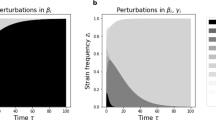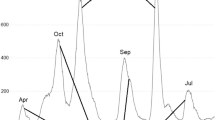Abstract
We study the identifiability of some mathematical models of spreading TB and HIV coinfections in a population and the dynamics of HIV-infection at the cellular level. Sensitivity analysis is carried out using the orthogonal method and the eigenvalue method which are based on studying the properties of the sensitivity matrix and show the effect of the model coefficient change on simulation results. Practical identifiability is investigated which determines the possibility of reconstructing coefficients from the noisy experimental data. The analysis is performed using the correlation matrix and Monte Carlo method, while taking into consideration the Gaussian noise in measurements. The results of numerical calculations are presented on whose basis we obtain the identifiable sets of parameters.
Similar content being viewed by others
References
B. M. Adams, H. T. Banks, M. Davidian, H.-D. Kwon, H. T. Tran, S. N. Wynne, and E. S. Rosenberg, “HIV Dynamics: Modeling, Data Analysis, and Optimal Treatment Protocols,” J. Comput. Appl. Math. 184, 10–49 (2005).
L. W. Roeger, Z. Feng, and C. Castillo-Chavez, “Modelling TB and HIV Co-Infections,” Math. Biosci. Eng. 6 (4), 815–837 (2009).
E. Carson and C. Cobelli, Modelling Methodology for Physiology and Medicine (Acad. Press, New York, 2001).
C. Cobelli and E. Carson, Introduction to Modelling in Physiology and Medicine (Acad. Press, New York, 2008).
S. Audology and L. Angio, “On the Identifiability of Linear Compartmental System: A Revisited Transfer Function Approach Based on Topological Properties,” Math. Biosci. 10 (5), 10–17 (1983).
S. I. Kabanikhin, “Definitions and Examples of Inverse and Ill-Posed Problems,” J. Inverse Ill-Posed Probl. 16, 317–357 (2008).
H. Miao, X. Xia, A. S. Perelson, and H. We, “On Identifiability of Nonlinear ODE Models and Applications in Viral Dynamics,” SIAM Rec. Soc. Ind. Appl. Math. 53 (1), 3–39 (2011).
K. Glover and J. Willems, “Parametrization of Linear Dynamical Systems: Canonical Forms and Identifiability,” IEEE Trans. Automat. Control. 19, 640–646 (1974).
R. Bellman and K. Astrom, “On Structural Identifiability,” Math. Biosci. 30 (4), 65–74 (1970).
M. Grewal and K. Glover, “Identifiability of Linear and Nonlinear Dynamical Systems,” IEEE Trans. Automat. Control 21 (6), 833–837 (1976).
S. Vajda, “Identifiability of First Order Reaction Systems,” React. Kinet. Catal. Lett. 11 (1), 39–43 (1989).
C. Cobeli and J. DiStefano, “Parameter and Structural Identifiability Concepts and Ambiguities: A Critical Review and Analysis,” Amer. J. Physiol. Reg. I, 3 (3), 369–380 (1980).
T. Tunali and T. Tarn, “New Results for Identifiability of Nonlinear Systems,” IEEE Trans. Automat. Control 15, 45–51 (1987).
V. F. Shcherbak, “Conditions for Identifiability of Dynamical Systems,” Mat. Fiz. 34, 105–108 (1983).
A. A. Levakov, “Identifiability of Nonlinear Systems,” Differentsial’nye Uravneniya 19 (6), 1074–1078 (1983).
V. V. Karelin, Methods for Identification and Optimization of Control Systems: Methodological Directions (St. Petersburg Univ., St. Petersburg, 1990) [in Russian].
A. A. Lomov, “Simultaneous Identifiability of Coefficients of Linear Difference Equations of the Object and Additive Disturbances,” Vestnik Novosib. Gos. Univ. Ser. Mat. Mekh. Inform. 15 (4), 46–57 (2015).
T. V. Avdeenko and S. A. Kargin, “Analysis of Identifiability of Linear Dynamical Models with Application of Separators of a Parametric Space,” Sibir. Zh. Indust. Mat. 9 (3), 3–16 (2006).
M. Saccomani and C. Cobeli, “Qualitative Experiment Design in Physiological System Identification,” IEEE Control System 3 (12), 18–23 (1992).
R. Brown, “Compartmental System Analysis: State of the Art,” IEEE Trans. Biomed. Eng. 14 (3), 31–41 (1980).
R. Brown, “Identifiability: Role in Design of Pharmacokinetic Experiments,” IEEE Trans. Biomed. Eng. 14 (3), 31–41 (1982).
M. Saccomani, S. Audoly, and L. Angio, “An Effective Automatic Procedure for Testing Parameter Identifiability of HIV/AIDS Models,” Bull. Math. Biol. 73, 1734–1753 (1978).
G. Bellu, M. Saccomani, S. Audoly, and L. D’Angio, “Daisy: A New Software Tool to Test Global Identifiability of Biological and Physiological System,” Comp. Meth. Prog. Biomed. Math. Biosci. 88 (1), 52–61 (2007).
N. Meshkat, C. E. Kuo, and J. J. DiStefano, “Finding and Using Identifiable Parameter Combinations in Nonlinear Dynamic Systems Biology Models and COMBOS: A Novel Web Implementation,” Plos One. 9 (10), e110261 (2014).
N. Meshkat, C. Anderson, and J. J. DiStefano, “Alternative to Ritt’s Pseudodivision for Finding the Input-Output Equations of Multi-Output Models,” Math. Biosci. 239 (1), 117–123 (2012).
A. Raue, J. Karlsson, M. P. Saccomani, M. Jirstrand, and J. Timme, “Comparison of Approaches for Parameter Identifiability Analysis of Biological Systems,” Bioinformatics 30 (10), 1440–1448 (2014).
S. I. Kabanikhin, D. A. Voronov, A. A. Grodz, and O. I. Krivorotko, “Identifiability of Mathematical Models of Medicine Biology,” Vavilov Zh. Genet. i Selek. 19 (6), 738–744 (2015).
A. F. Villaverde and A. Barreiroc, “Identifiability of Large Nonlinear Biochemical Networks,” MATCH Commun. Math. Comput. Chem. 76, 259–296 (2016).
A. Saltelli, K. Chan, and M. Scott, Sensitivity Analysis. Wiley Series in Probability and Statistics (John Wiley & Sons, New York, 2000).
A. Raue, C. Kreutz, and T. Maiwald, “Structural and Practical Identifiability Analysis of Partially Observed Dynamical Models by Exploiting the Profile Likelihood,” Bioinformatics 25 (15), 1923–1929 (2009).
D. G. Cacuci, Sensitivity and Uncertainty Analysis: Theory, Vol. 1 (Chapman & Hall/CRC, New York, 2003).
K. Zh. Yao, B. M. Shaw, B. Kou, K. B. McAuley, and D. W. Bacon, “Modeling Ethylene/Butene Copolymerization with Multi-Site Catalysts: Parameter Estimability and Experimental Design,” Polymer React. Eng. 11 (3), 563–588 (2003).
V. Latyshenko, O. Krivorotko, S. Kabanikhin, Sh. Zhang, V. Kashtanova, and D. Yermolenko, “Identifiability Analysis of Inverse Problems in Biology,” in Proceedings of 2nd international Conference on Computational Modeling, Simulation, and Applied Mathematics (CMSAM-2017), Beijing, China, October 22–23, 2017 (DEStech, Lancaster, Pennsylvania, 2017), pp. 567–571.
T. Quaiser and M. Mönnigmann, “Systematic Identifiability Testing for Unambiguous Mechanistic Modeling — Application to JAK-STAT, MAP Kinase, and NF-kB Signaling Pathway Models,” BMC Syst. Biol. 3, 50–71 (2009).
M. Rodriguez-Fernandez, J. A. Egea, and J. R. Banga, “Novel Metaheuristic for Parameter Estimation in Nonlinear Dynamic Biological Systems,” BMC Bioinformatics 7, 483–500 (2006).
N. Metropolis and S. Ulam, “The Monte Carlo Method,” J. Amer. Stat. Assoc. 44, 335–341 (1949).
H. T. Banks, S. I. Kabanikhin, O. I. Krivorotko, and D. V. Yermolenko, “ANumerical Algorithm for Constructing an Individual Mathematical Model of HIV Dynamics at Cellular Level,” J. Inverse Ill-Posed Probl. 26 (6), 859–873 (2018).
S. I. Kabanikhin, O. I. Krivorotko, D. V. Ermolenko, V. N. Kashtanova, and V. A. Latyshenko, “Inverse Problems of Immunology and Epidemiology,” Eurasian J. Math. Comp. Appl. 5 (2), 14–35 (2017).
D. S. Callaway and A. S. Perelson, “HIV-1 Infection and Low Steady State Viral Loads,” Bull. Math. Biol. 64, 29–64 (2001).
H. T. Banks, Sh. Hu, and W. C. Thompson, Modeling and Inverse Problems in the Presence of Uncertainty (Chapman and Hall/CRC, New York, 2014).
Funding
The authors were supported by the Russian Foundation for Basic Research (project no. 18-31-20019) and the Council on Grants of the President of the Russian Federation (Agreement no. 075-15-2019-1078 (MK-814.2019.1)).
Author information
Authors and Affiliations
Corresponding authors
Additional information
Russian Text © The Author(s), 2020, published in Sibirskii Zhurnal Industrial’noi Matematiki, 2020, Vol. 23, No. 1, pp. 107–125.
Rights and permissions
About this article
Cite this article
Krivorotko, O.I., Andornaya, D.V. & Kabanikhin, S.I. Sensitivity Analysis and Practical Identifiability of Some Mathematical Models in Biology. J. Appl. Ind. Math. 14, 115–130 (2020). https://doi.org/10.1134/S1990478920010123
Received:
Revised:
Accepted:
Published:
Issue Date:
DOI: https://doi.org/10.1134/S1990478920010123




